No trip to the city of bagels and the Lajkonik would be complete without a visit to the famous Wawel Hill. After all, this is where the castle is located, not only playing a crucial role in Krakow’s history but also standing as one of the most important landmarks in all of Poland.
The Royal Castle on Wawel is currently one of the most historically significant sites in Poland and one of the most important and frequently visited museums in the country. However, Wawel had to travel quite a long path to reach this point. From a hill protecting against the rising waters of the Vistula River, through centuries as a royal residence, to Prussian looting, Wawel’s palace corridors still house many remnants of its rich history. This is precisely why anyone planning a tour of southern Poland should include this landmark on their must-see list.
The Long History of Wawel and Its Castle
Wawel is not the first instance where a hill served as a center of power, a religious hub, or a defensive stronghold. Just think of Rome’s Capitoline Hill or the Alhambra in Granada. The Wawel Hill has provided a refuge for the inhabitants of the surrounding wetlands since the Paleolithic era. However, its true history as a royal seat began at the end of the 10th century when Bolesław the Brave incorporated the Wawel stronghold into the Piast realm, and after the establishment of a bishopric in Krakow, the first cathedral was built on Wawel.
In 1039, under the rule of Casimir the Restorer, Krakow became the capital of Poland, and the Wawel Castle became the official residence of the kings. Given the immense significance of this residence for the entire country, it required adequate protection. In the 12th century, the first stone defensive structure, a Romanesque tower known as a “stołp,” was erected next to the castle.
The rise and fall of Krakow’s castle
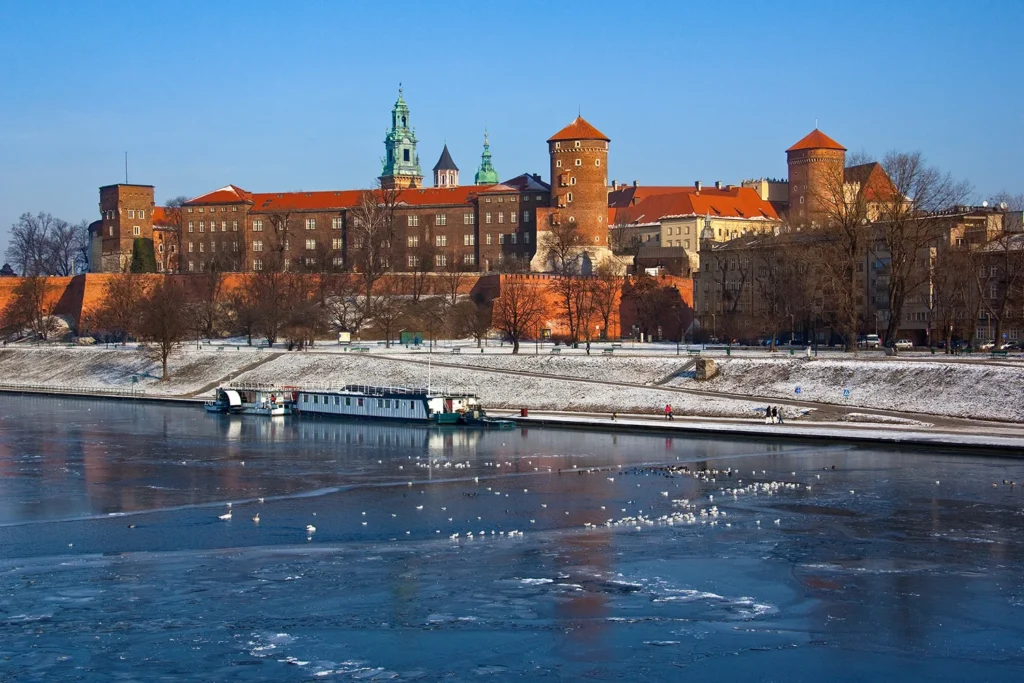
The royal palace flourished between the 14th and 16th centuries. The rulers’ residence was then divided into the upper castle, also known as the high castle, which served as the king’s direct residence, and the lower castle, filled with utility buildings, houses, and churches. The former palatium was continuously expanded, with the eastern wing and arcades being constructed, and the royal court began to attract distinguished artists from across Europe.
However, the good fortune could not last forever. The capital’s move to Warsaw led to a significant deterioration of the castle. The former residence was visited by monarchs only occasionally by then, but it was the partition era that dealt the final blow. After Poland lost its independence, Austrian, Russian, and Prussian troops successively occupied Wawel, which only revived at the beginning of the 20th century.
It was during this time that the cathedral underwent thorough restoration, most palace spaces were renovated, and a viewing loggia was constructed. During World War II, the palace served as the seat of the Nazi governor, though it did not suffer major damage, and shortly after the war, it passed into the hands of Polish state institutions.
Visiting Wawel Castle
Those who only have time for a short walk around the hill while visiting Krakow can admire the solid walls protecting the former royal residence and the beautiful arcaded inner courtyard. However, to truly discover the beauty of this place, it is definitely better to explore its interior.
The entire residence offers its visitors more than 70 exhibition rooms, most of which, through both exhibits and décor, recreate the atmosphere of the Renaissance or Baroque periods. What kind of exhibits are we talking about? That depends on which part of the palace you decide to visit.
Castle I
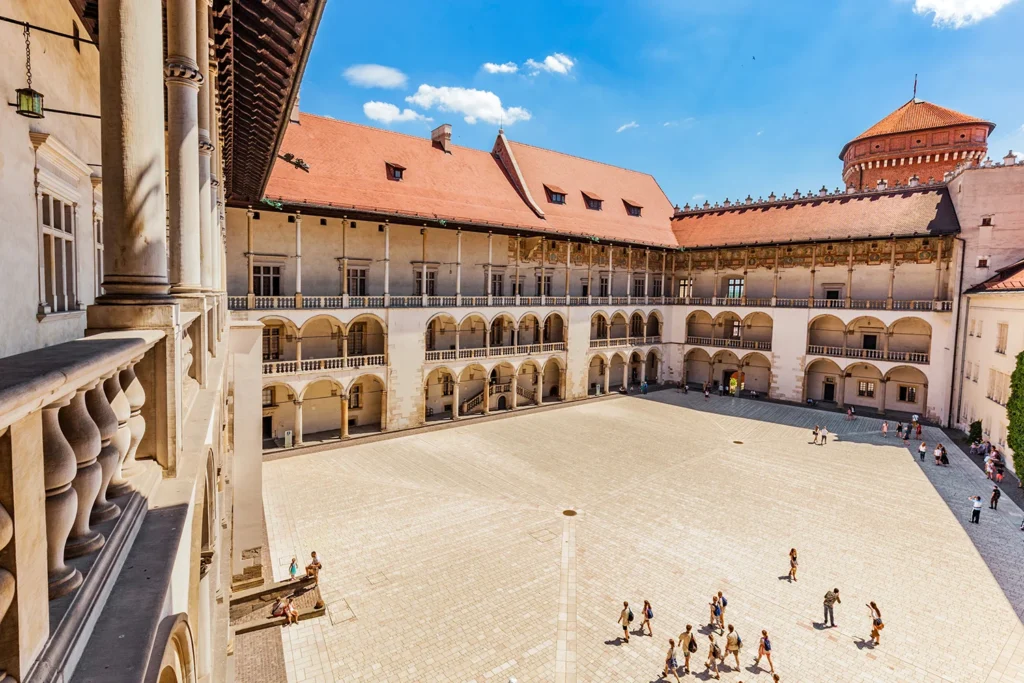
As the residents of Wawel Castle changed many times, the purpose of the palace rooms also shifted over the years. However, the first-floor rooms consistently served as private royal apartments. On this level, you can discover what the royal dining rooms, wardrobes, guest rooms, and bedrooms looked like, as well as which antique furniture has survived to this day. You can also see the architectural features that still adorn the palace halls. The largest room is the Columned Hall, which likely functioned as the dining room of King Sigismund I the Old. Its interior is decorated with gilded chandeliers and portraits of Polish dignitaries hanging on the walls.
A special area on the first floor is the Porcelain Cabinet, which houses a collection that is the most significant of its kind in Central Europe. It includes both Far Eastern and European porcelain items such as candlesticks, tableware, vases, and vessels. Visitors are most amazed by a space that imitates a hall of mirrors, displaying what seems to be levitating porcelain.
Eastern Art
A separate section of the first floor is an exhibition that allows you to briefly experience the atmosphere of the Orient in the heart of Krakow. Thanks to former trade connections, several rooms now showcase works of art from the Near and Far East. Among them are fragments of Turkish tents, silks and tapestries, weapons and armor, as well as charming Chinese and Japanese vases and vessels.
Castle II
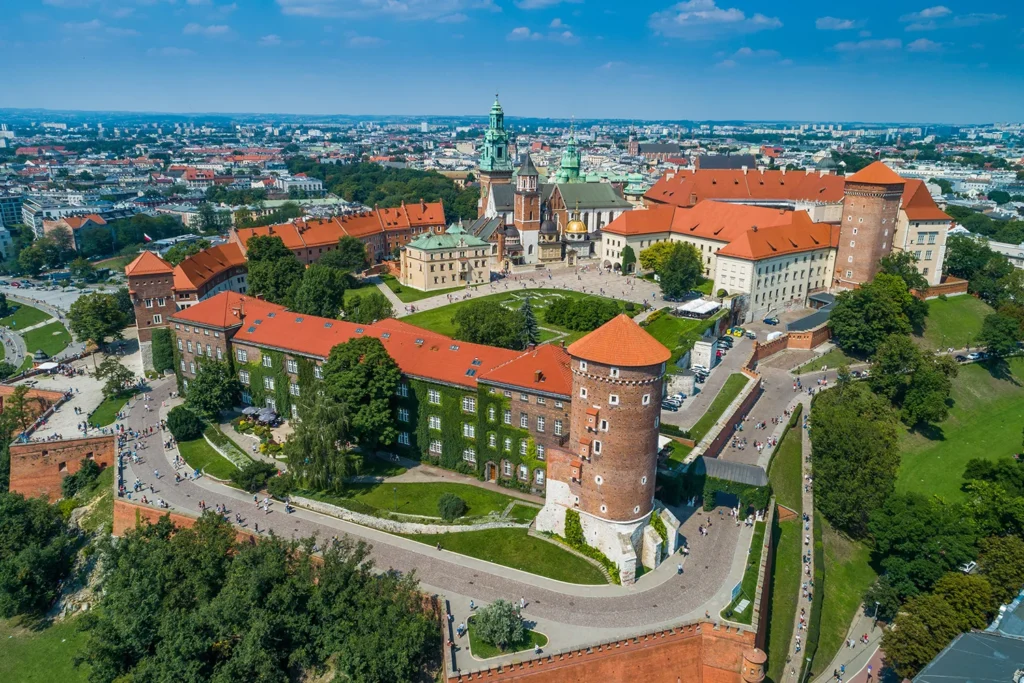
Unfortunately, I can’t tell you about all the current exhibitions on the second floor of Wawel Castle. This is because a large portion of this level has been adapted for temporary exhibitions, which change every few months. However, part of the tour still includes permanent exhibitions, mainly featuring the royal state rooms. These rooms are significantly larger than those on the lower floor. This isn’t surprising, as this is where meetings of the parliament and senate, courts, royal audiences, weddings, and balls were held.
Most of the rooms are named after the themes of the paintings or friezes that adorn their walls. This is the case for the Tournament Hall, the Hall Under the Zodiac, and the Hall Under the Planets. The private royal chapel and the study rooms are also noteworthy, especially the Collector’s Cabinet, lined with colored leather. The most important rooms, however, are the Envoys’ Hall, which served as a throne room, and the largest of all, the Senators’ Hall, which, despite its name, was not only used for senate meetings but also for celebrations, theatrical performances, and weddings.
The Castle’s Underground
Who, while wandering through an old castle, wouldn’t want to peek into its underground chambers? It’s well known that such peculiar corners often hide extraordinary secrets. In the case of Wawel, the greatest of these secrets is the Lapidarium, a place where stones tell dozens of fascinating stories about this site. Among the more than three thousand objects that make up the collection, stone statues, fragments of buildings, and tomb monuments take center stage.
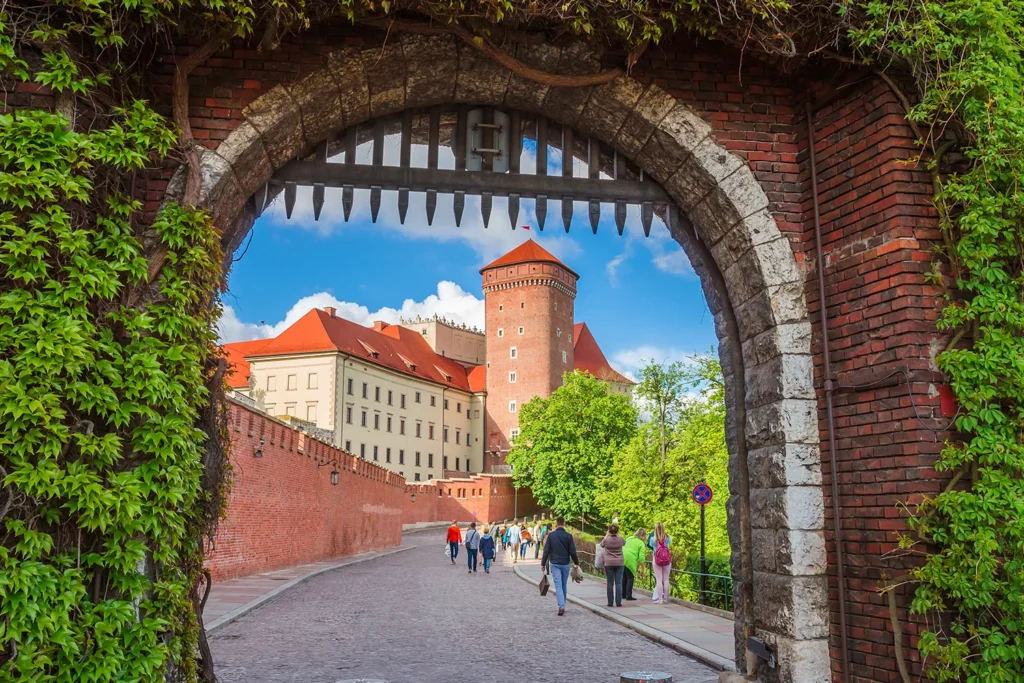
The castle’s cellars are also home to the permanent exhibition Lost Wawel, which showcases an exceptionally wide array of objects. Next to a small kitchen filled with 16th-century kitchen and tableware, you’ll find the remains of a carriage house and stables, as well as plaster casts of the decorations from the Sigismund Chapel, considered a model work of Renaissance art in Poland. This exhibition also includes relics related to the Wawel Cathedral and a substantial collection of tiles from the 16th and 17th centuries, along with stove models.
From April to October, as you explore the castle’s underground, you’ll also have the chance to visit the Church of St. Gereon and the Chapel of St. Mary of Egypt. Three connected rooms in the western wing showcase the remains of a Romanesque church from the 11th century and a Gothic chapel, which was built on its site in the 14th century.
Crown Treasury
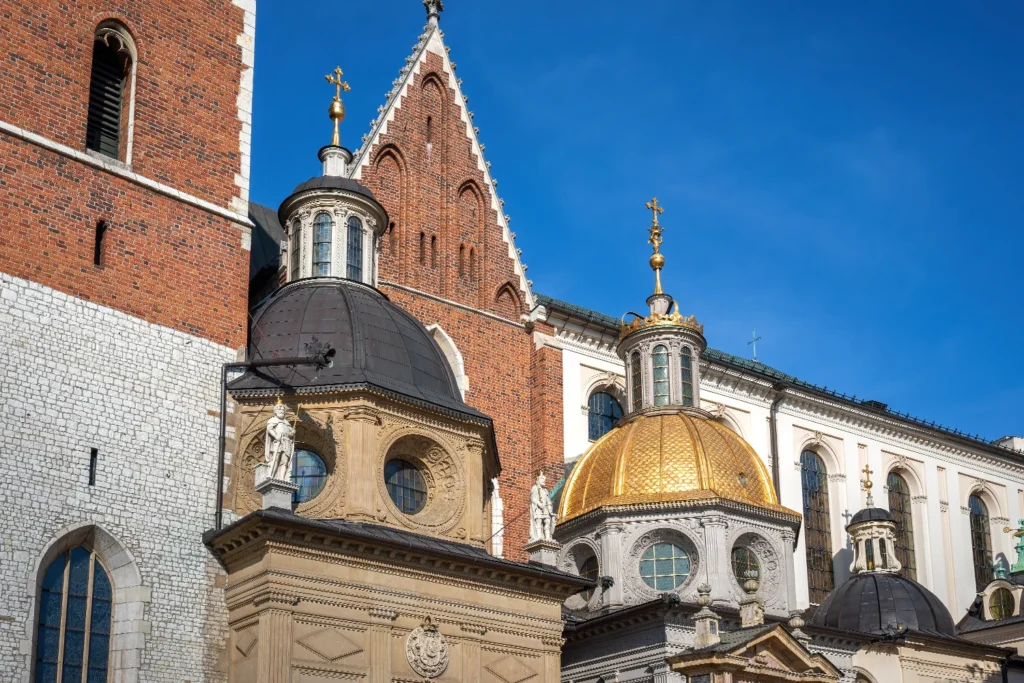
If you’re visiting Wawel Castle not for the elegant interiors, but for priceless treasures, then you mustn’t miss a visit to the Crown Treasury. Today, it serves as a typical museum space, but in the past, these same rooms were used to protect not only the coronation insignia but also all the valuables that made up the official assets of the state.
The current collection is only a fraction of what was once housed here. Most of the items were looted by Prussian forces at the end of the 18th century. Fortunately, since 1930, the modest collection of remnants from the former treasury has been regularly supplemented with new jewels, works of art, ornaments, and historical memorabilia.
One thing is certain – you can’t leave the treasury without stopping at the display case of the Szczerbiec. It is the most valuable Polish historical artifact and the only recovered coronation insignia of the Piast dynasty. This coronation sword was used to bestow power upon almost every Polish king from the 14th century until the mid-18th century. And while the Szczerbiec may be compared to the crown’s greatest jewel, the other treasures in the treasury are no less impressive. Behind the museum glass, you can see battle trophies, banners, garments and insignia, as well as gold and silver vessels and extraordinary masterpieces of jewelry.
Armory
This part of the museum will likely appeal most to fans of military history. In the Armory Hall, you can closely examine swords, medieval armor, shields, and lances. The display cases are filled not only with Polish but also Western European sabers, rapiers, daggers, as well as handheld firearms (such as crossbows) primarily used by hunters. In the basement rooms of the Armory, you’ll find cannon barrels and artillery, above which hang reproductions of Teutonic banners captured by Władysław Jagiełło at the Battle of Grunwald.
Seasonal Routes
A potential downside of visiting Wawel Castle during the summer is, of course, the large crowds. However, there are significant advantages to touring during peak season. Only between April and October, while visiting the Royal Castle, you can take advantage of additional seasonal routes, such as visiting the Sandomierz Tower. It’s one of the so-called “fire towers,” offering a beautiful view of Krakow and its surroundings from its top. Similar city panoramas can be enjoyed during the tour of the arcades, specifically from the viewing terrace of the Small Tower, which connects the arcades with the administrative building. However, there are many more such seasonal attractions to explore.
Royal Gardens
This space, with its plant compositions, greenery arrangements, and pathway layout, captures the atmosphere of gardens from past eras. All of this is thanks to years of research that made the reconstruction of this park possible. The gardens may be small, but it’s worth taking a breath of fresh air surrounded by a small vineyard and the ornamental plants of the upper terrace. The lower terrace, which is a bit larger, will surprise you with its continued botanical patterns, a pleasant orchard, a wooden gazebo, and the aroma of herbs filling the air.
From time to time, the Royal Gardens also serve as a backdrop for temporary exhibitions, mainly showcasing sculptures or installations. Be sure to visit them, especially if you’re planning a longer walk around the castle, because if you have tickets to the underground or any of the two floors of the building, entry to the gardens is free.
Dragon’s Den

A long time ago, the city of Krak was terrorized by a dragon. Under the threat of destroying the city, the dragon forced its residents to regularly offer sacrifices. Many brave knights tried to defeat the monster, but none succeeded. It was finally a clever shoemaker named Skuba who managed to trick the creature by offering it a lambskin stuffed with sulfur. After devouring the “animal,” the dragon drank so much water that it eventually exploded.
FUN FACT: Some of you may have heard of the shoemaker Dratewka instead of Skuba. In fact, they are the same character. The name “Skuba” was used by Kornel Makuszyński in his tale “The Wawel Dragon” (1937). Maria Kownacka, in her version of the story, gave the brave shoemaker the name Dratewka.
Most of you have probably heard about the Wawel Dragon. After all, its story is the most famous legend associated with Krakow. The dragon is commemorated by a statue sculpted by Władysław Chromy, located on the Vistula Boulevard. This 1972 sculpture attracts tourists who not only want to take a photo of the legendary dragon but also see for themselves that every few minutes it breathes real fire.
However, if the modern statue of the monster isn’t enough proof of its existence for you, there’s another place you must see. Wawel Hill is not only home to the Royal Castle, towers, and arcades but also a peculiar cave carved into its western slope. This karst cave formed about 12 million years ago and was supposedly the original lair of the legendary dragon. In later times, the chamber was used as a storage room and a banquet hall for a tavern. The entire cave is 270 meters long, but the accessible tourist route during the season covers only 81 meters. This is more than enough to admire the rock ledges, chimneys, and karst formations.
How to buy tickets to the castle?
Before purchasing your ticket, consider which tour option will be best for you, as entry to each part of the castle requires a different type of ticket. There are also combined tickets available.
The “Wawel. The Most Precious” tour offers a guided visit to Castle I, Castle II, the Underground, the Crown Treasury, and the Armory. For those who are truly dedicated (as this involves more than 5 hours of sightseeing), there is also a special “Wawel for Enthusiasts” ticket, which grants access not only to all exhibitions open on the day but also to the interiors of the Manor House in Stryszów and selected areas of Pieskowa Skała Castle. You can purchase tickets for Wawel Castle, as well as tours around Krakow, the Wieliczka Salt Mine, or the Auschwitz-Birkenau Memorial and Museum, on the GetYourGuide website.
Practical information
- It is best to purchase tickets for the Royal Castle on Wawel in advance. This way, you can avoid standing in long lines and reduce the risk of tickets being sold out.
- Address: Wawel 5, 31-001 Kraków, Poland
- Buy tickets on GetYourGuide